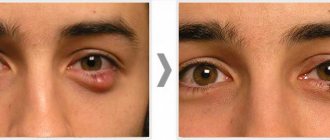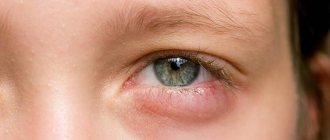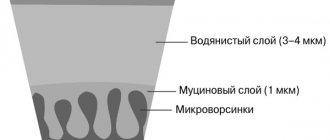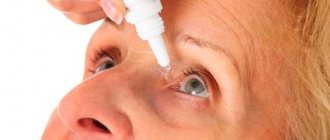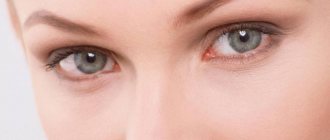Inflammation of the eye muscle: features of the disease
Ocular myositis occurs predominantly in men over 30 years of age who lead a sedentary lifestyle and whose professional activities involve a heavy load on the visual organs. Inflammation most often takes a one-sided form. Myositis of the oculomotor muscles can be primary or secondary. The first occurs as a result of autoimmune diseases, when the body's cells attack its own tissues, and not just harmful ones. Because of this, the eye muscles increase in size and thicken. This leads to swelling of the eyelids. Symptoms of secondary myositis can vary. They depend on the factors that provoked the disease.
Diseases that can lead to the development of myositis:
- Dermatomyositis. Severe progressive pathology, which, as a rule, occurs on its own; its causes cannot be detected. Various organs can be affected, most often the skin and muscles.
- Polymyositis is a systemic disease in which, as a rule, the symptoms intensify gradually, affecting mainly the muscles of the shoulder and pelvic girdle and neck. There is no effective treatment.
- Myositis with inclusions is a disease that belongs to the group of inflammatory myopathies. Characterized by muscle weakness. There is no effective treatment; drugs that suppress the immune system do not improve the condition.
- Systemic lupus erythematosus is an autoimmune disease of connective tissue. May be accompanied by inflammation in muscle tissue.
- Scleroderma is an autoimmune pathology in which connective tissue is damaged. This affects the skin, musculoskeletal system, blood vessels, heart, kidneys, digestive organs, and lungs.
- Rheumatoid arthritis is a systemic connective tissue disease that primarily affects small joints, but inflammation in the muscles can also develop.
The main causes of ocular myositis
Inflammation of the eye muscle of the secondary type occurs due to exposure to toxic substances and other unfavorable factors on the eyes. The most common causes of pathology:
- mechanical injuries to the eyeballs, including burns;
- constant strain on the eyes in the absence of therapeutic exercises to relax the eye muscles;
- infectious ophthalmological diseases of viral, fungal or bacterial etiology;
- eye surgeries;
- alcohol abuse, intoxication with narcotic substances and industrial poisons;
- hypothermia.
Other factors can also provoke inflammation of the eye muscles. There are cases when myositis becomes a consequence of a stressful situation or mental stress.
How does myositis manifest?
This disease can occur in acute and chronic form, and can be unilateral or bilateral. The intensity of symptoms varies. Symptoms are determined by the causes of the pathology, the state of immunity, and the age of the patient. Characteristic symptoms of ocular myositis:
- bursting pain in the eyeball, intensifying when moving it;
- swelling of the eyelids and conjunctiva, which leads to a narrowing of the palpebral fissure;
- tearfulness;
- increased photosensitivity;
- exophthalmos - outward displacement of the eye;
- poor mobility of the eyeball;
- headache from the inflammatory process;
- increase in body temperature.
The disease is acute in infectious eye diseases. If inflammation occurs due to hypothermia or problems with the immune system, then its signs are not so intense.
How does treatment of myositis depend on the symptoms of the disease?
Treatment tactics are largely determined by the symptoms and causes of the disease. In systemic inflammatory diseases, the symptoms of myositis often constantly progress, sometimes stopping with great difficulty. Therefore, treatment of myositis is long-term. Strong drugs are used that suppress the activity of the immune system. To improve the function of the affected muscles, the doctor prescribes physical therapy.
For viral infections, no special treatment is required; measures are aimed at combating the manifestations of the disease. But if it turns out that the inflammation is caused by bacteria (which is rare), the doctor will prescribe antibiotics.
If the inflammatory process occurs as a result of rhabdomyolysis (muscle breakdown), the symptoms of myositis may be accompanied by signs of acute renal failure. This is a dangerous condition that requires hospitalization.
In some cases, the inflammatory process in the muscles is temporary and passes quickly, while in others the disease occurs in a chronic form, the symptoms progress over time, and the patient’s condition worsens. In order to prevent serious complications, it is better to consult a doctor in time. To make an appointment with a doctor at our neurological clinic at a time convenient for you, contact us by phone.
We will call you back
Leave your phone number
The disease myositis can be caused by any reasons that lead to an inflammatory process in the muscles. They are conventionally divided into the following groups: systemic inflammatory processes in the body (often they are autoimmune in nature), infections, injuries, side effects of drugs, rhabdomyolysis (destruction of muscle tissue).
Modern methods for diagnosing myositis
The doctor must accurately determine the nature of the disease, its degree and form of progression. For this purpose, several diagnostic procedures are prescribed:
- visual acuity test;
- serological blood testing used to detect viruses and bacteria;
- computed tomography and/or MRI;
- tonometry;
- examination of the anterior chamber of the eye - gonioscopy;
- biomicroscopy;
- ophthalmoscopy;
- electromyography.
After carrying out all these procedures and making an accurate diagnosis, the doctor determines the method of treating ocular myositis. What treatment methods for this pathology are used today?
Modern methods of treating inflammation of the eye muscle
The disease is treated with conservative methods. The patient is prescribed medications and physiotherapeutic procedures. Etiotropic treatment aimed at destroying viruses or bacteria is used only when the disease is of infectious origin.
Depending on a particular form of the disease, the following types of medications and procedures are used:
antibiotics injected subcutaneously into the lower eyelid area;
non-steroidal anti-inflammatory drugs that help eliminate pain and inflammation;
angioprotectors that strengthen blood vessels, which helps prevent the development of pathologies of the retina;
Radiotherapy and physiotherapy are prescribed in courses if there is no effect from medications.
Eye injuries that result in damage to the eye muscles are sometimes treated with surgery. During the operation, the structure of injured muscle fibers is restored. The acute form of myositis is treated for approximately 4-6 weeks. If it is chronic, treatment is delayed. It takes 2 months to completely get rid of it. In this case, the patient is recommended to visit an ophthalmologist at least once every 2 months after recovery for the first six months.
Principles of treating ailments
Diseases of the muscular system of the eyes: strabismus
Diseases of the muscular system of the eyes, as a rule, are amenable to treatment, but its organization requires high-quality diagnostics.
The latter necessarily includes:
- Analysis of the patient's symptoms. With pathologies of the muscular structures of the visual system, diplopia, nystagmus and eye pain radiating to the head are observed.
- A detailed examination of the affected eyes and checking their physiological functions (supplying light to the pupil, tracking an object, etc.).
- Carrying out instrumental diagnostics. In the case of damage to muscle fibers, strobometry (determines strabismus), ultrasound, CT of the eyes (detect tissue defects) and electroneuromyography (used to check nerve fibers) are most often used.
Based on the results of the examinations, the patient is prescribed the optimal course of therapy specifically for the characteristics of his clinical case. Diseases of the muscular system of the eyes in an equal number of cases respond to both drug and surgical therapy.
In determining the treatment method, an important role is played by the clinical picture of the manifestation of the pathology and the degree of its development. Naturally, the stronger and more dangerous the disease, the greater the chance that surgical treatment methods will be used for its treatment.
Prevention of ocular myositis
How to prevent the development of this pathology? You need to take care of your health, toughen up, strengthen your immune system, do eye exercises several times a day, especially with increased visual stress, and play sports. If you work in adverse conditions, wear a protective mask or goggles.
Don't start the disease. At the first symptoms, consult a doctor. If left untreated, myositis can cause complete loss of vision.
Almost all of our organs are protected by the skin: most often, viruses and bacteria enter them when we ourselves allow it. But the eyes are a different matter: they are constantly in contact with the external environment, and often suffer from this. The condition of the eyes is affected by cold and heat, dryness and humidity, wind and dust, chemicals and bright light, and in our age another “powerful” factor has been added - working at a computer. Nowadays, eye inflammation will not surprise anyone: probably every person - and this especially applies to city dwellers - has at least once encountered problems such as redness of the eyes, watery eyes and itching, and these are not the most unpleasant symptoms. Today we will focus on such an unpleasant condition as eye inflammation, we will understand its causes and how to relieve it.
On topic: Pills for making muscles
Symptoms of asthenopia
As a rule, patients with asthenopic syndrome complain of heaviness, pain, tension, double vision, increased lacrimation, an irresistible desire to close the eyes, noticeable redness of the sclera, inability to concentrate the gaze at a close distance; the most eloquent (or simply prone to introspection) also talk about a sharp decrease in general mental performance, an increase in the number of “careless errors,” headaches, creeping drowsiness, “sand” or a foreign body in tired eyes. With all the variety of symptoms, these uncomfortable sensations in various combinations always arise as a result of more or less prolonged visual concentration - otherwise one has to think not about asthenopia, but about some other ophthalmopathology that manifests similar manifestations.
Speaking about the most tiring loads for the eyes, one cannot help but refer to statistical data, known and understood by many, as they say, from their own experience: sadly, working on computer monitors (even the most modern and “safe for the eyes”) is still exhausts the visual system faster than any other work. Among the sad leaders in this list, driving a car at night is also mentioned (which is easily explained, given the highest concentration of visual attention and the sharp, traumatic contrast between absolute darkness and the blinding headlights of cars oncoming or reflected in the mirror); then comes reading, and only after this comes the actual professional types of “visual” activities, such as text proofreading, sewing, radio editing, etc.
Main reasons
For what reasons can the eyes become inflamed? Something has already been said above, but there are also injuries, various burns - including chemical ones, exposure to allergens and household chemicals, herpes viruses and other infectious agents. Of course, improper work at the computer and high visual loads are common causes, but you should not diagnose yourself and treat yourself with “improvised” means - it is better to visit an ophthalmologist.
Even if you do not require serious treatment, only a doctor can determine the exact cause of eye inflammation and indicate how to get rid of it. By turning to a specialist, you will avoid complications and unnecessary costs - by the way, it is also better to consult a doctor about folk remedies.
When self-medication is contraindicated
Let's list some causes of eye inflammation that you shouldn't deal with on your own, although folk remedies and pharmacy drops can help - more on that later.
For example, many have heard about conjunctivitis - inflammation of the conjunctiva, or mucous membrane of the eye. Just because the disease has been known for a long time does not make it any less dangerous. There are several types of conjunctivitis: it can be caused by bacteria, viruses, or allergens, and it can occur in acute or chronic form - the treatment is always different.
Another type of eye inflammation is keratitis. This problem is quite serious: the cornea of the eyes becomes inflamed, and the reasons can be very different. These are injuries - chemical and mechanical; exposure to bacteria, viruses and fungi; lack of vitamins and weakened immunity; damage to the optic nerves, which, in turn, also does not arise out of nowhere.
Purulent inflammation of the eyes is also a common occurrence, and they are usually caused by streptococci and staphylococci. The success of treatment depends on timeliness - however, as in the next case, when local inflammation occurs under the eyelids or just under the eye. Such inflammations can be symptoms of ordinary barley, which often occurs due to a lack of vitamins and slagging - barley is not so difficult to treat - or a serious disease - blepharitis, which is very difficult to treat - often for many years.
We will not list all types of eye inflammation: the symptoms may be similar, but specific and professional treatment is always required.
Prevention of asthenopia
An attentive reader has long noticed that in descriptions of generally accepted therapeutic protocols (for almost any variant of asthenopia), optimization of the work and rest regime is most often mentioned. Of course, first of all, this applies to those types of activities that involve continuous, monotonous and intense visual load. Prevention measures are just as simple and just as effective: regular eye rest - at least once an hour, lasting at least ten minutes, preferably with your eyes closed or performing some simple relaxation exercises (for example, alternately shifting your gaze from nearby objects into the distance and back). A very important factor is the illumination of the working field: there should be enough light, but not too much, and, in addition, the sharp contrast between the local bright spot and the surrounding twilight is very harmful to the eyes. We should not forget about the optimal distance from the eyes to the object of visual concentration (at least 30-40 cm); It is with this in mind that work furniture should be selected and configured.
Finally, it is extremely necessary to organize good nutrition to ensure a sufficient amount of proteins, vitamins and microelements entering the body; A deficiency of these substances affects the state of the visual system no less (and in some cases more) detrimentally than the functioning of the gastrointestinal tract, heart or brain. Therefore, in winter and especially in early spring, it is advisable to take a course of nutritional and vitamin complexes for the eyes prescribed by an ophthalmologist.
Eye drops to relieve inflammation
In addition to redness, itching and tearing, there are other symptoms of eye inflammation: the eyes become swollen, it becomes painful to look at the light, or there is simply a feeling of discomfort - for example, with severe strain.
In all these cases, eye drops can help relieve eye inflammation - there are now a lot of them. Let's talk about some - just for reference.
For conjunctivitis, blepharitis and keratitis, Levomycetin drops are often prescribed: their active substance has a pronounced bacteriostatic, and in large doses, bactericidal effect, and is a broad-spectrum antibiotic - this means that during treatment it can kill a variety of pathogenic bacteria. Usually the drug is tolerated normally if the dosage is not exceeded: this rule applies to any eye drops, including those that have been known for a long time.
Sodium sulfacyl, or Albucid, has been used in ophthalmic practice for a long time, and also disrupts the vital activity of bacteria, preventing them from multiplying. Albucid should be used in the early stages of the disease - the sooner the better, and it is usually prescribed in parallel with Levomycetin.
If eye inflammation intensifies due to these diseases, hormonal drops may be prescribed - this is already serious, so it is better to start treatment on time.
Sodium sulfacyl is also used in the treatment of styes and other inflammations of the eyelids, but there is another “old” remedy - penicillin. Penicillin drops are still effective in the fight against certain types of bacteria, and this is another reason to see a doctor on time - you can often do without expensive medications. If penicillin has little effect, drops with erythromycin are prescribed: this drug is also inexpensive and copes with many bacteria.
On the subject: Why are muscles needed for
Among the drops used to treat tear production disorders, the most famous are Vizin and Natural Tear. The first drug is quite affordable, but now a more effective Visine Pure Tear has appeared - it can cost 2-3 times more.
In general, there are many such drops today, used mainly to moisturize the eyes. You can recall Inoxa, with extracts of cornflower, chamomile, elderberry and other medicinal plants, and more modern Oxial or Hilozar-Komod drops with hyaluronic acid - they effectively moisturize, but their price is also quite high.
If the disease is of an allergic nature, Vizin, Naphthyzin or Okumetil may be prescribed. These drugs relieve inflammation and swelling, but are often addictive - usually when used uncontrolled or for too long.
Often, the use of drops with vitamins helps to relieve inflammation of the eyes: they are safer and do not cause side effects.
Folk remedies for treating eye inflammation
Now about folk remedies, the simplest and most accessible ones - their choice also depends on the type of eye inflammation.
For conjunctivitis, collecting herbs helps: toadflax, black elderberry and blue cornflower. The herbs are taken equally and mixed, pour 3 tsp. mixture with boiling water (2 cups), and leave in a thermos for 8 hours. The infusion is filtered and the eyes are washed with it; you can do compresses.
For simple blepharitis, the edges of the eyelids are lubricated with almond oil, but this is a temporary measure - this disease should be treated by a specialist.
Barley is treated with the usual infusion of calendula. Inflorescences (15-20 pieces) are brewed with a glass of boiling water, covered and left for 40 minutes, filtered and used for rinsing and lotions.
Chamomile infusion and mint decoction help with various eye inflammations.
Chamomile flowers (1-2 tsp) are brewed with a glass of boiling water, after 15 minutes, filter and wash the eyes. If there is swelling, lotions are applied to the eyes.
Mint decoction is prepared in almost the same way: 1 tbsp. Leaves are brewed with 250 ml of boiling water, but also simmered over low heat for about 10 minutes. The cooled and strained broth is moistened with gauze pads and applied to the eyes for 10 minutes, several times a day.
Eyes, as already said, can become inflamed for various reasons - timely care can protect them. Dirt or makeup residue should not get into your eyes, and when working at a computer you need to follow at least the basic rules - it won’t be difficult to learn them. To maintain eye health, you need to at least take vitamins and follow a daily routine - this will already help strengthen your immune system and avoid many serious diseases.
Ocular myositis is a disease during which one or more of the outer eye muscles become inflamed. This is a rare disease, most often affecting one eye. Young people and middle-aged people get sick. Men get sick more often. This disease develops in people whose work is sedentary (this is the work of representatives of the music industry, people associated with working on computers).
Be vigilant - if the disease is not cured in time, there may be various kinds of complications. No one is talking about surgical intervention, but it is quite possible that you will have to go to hospital for inpatient treatment, especially if complications begin with areas of the body that are located on the face.
Remember, everyone may need first aid. Always contact experienced professionals for any changes on your face.
Myositis of the eye - what affects it and how?
The occurrence of muscle inflammation is influenced by the presence of:
- infectious diseases,
- infectious infections that are parasitic in nature,
- chronic process, which contributes to the appearance of poisoning of the body,
- work-related ailments of the patient that appear due to prolonged muscle tension or uncomfortable body position while at work,
- prior injury or non-specific physical activity, frequent exposure to cold, muscle cramps, which can contribute to the development of myositis due to injury,
- hypothermia (because of this, inflammation often develops in children),
- mental overstrain or stressful situations that cause the occurrence of responses of a certain nature in the patient’s body, permanent muscle tension.
If we talk about the course of the disease, then all inflammatory processes can be acute or chronic.
| Acute forms are characterized by rapid development after an infectious disease has been suffered or muscles have been injured. Its intensity is also determined by the accompanying factors, hypothermia and muscle tension. | Chronic forms of the disease can develop in a person because the acute form was poorly treated. It is characterized by pain after the muscles have been overstrained, hypothermia or sudden changes in weather conditions in the external environment. |
On the subject: Numbness of the muscles of the face
Depending on the distribution, myositis can be local or diffuse.
Diffuse forms of the disease or polymyositis are usually not characterized by intense pain. It is more characterized by a gradual increase in weakness, accompanied by swelling of the affected areas. Also, joints that are nearby may be involved in the process. This can lead to arthritis.
Endocrine ophthalmopathy: what is it?
The inflammatory process and swelling in the tissues of the retrobulbar area is accompanied by a complex of ophthalmological symptoms. A characteristic sign is bulging of the eyes, impaired traction of the upper eyelid, negative changes in the cornea against the background of exophthalmos. Pathology affecting the organs of vision develops against the background of autoimmune lesions of the thyroid gland.
Endocrine ophthalmopathy is one of the complications of Graves' disease. Bug-eyedness is a specific sign of image intensifier. If the eyeballs bulge, the patient should consult an endocrinologist, then visit an ophthalmologist.
What are the symptoms of ocular muscle myositis?
There are main symptoms of myositis that accompany any of its forms and types. Usually the muscles hurt. Increased discomfort occurs when weather conditions change, as well as at night. There are also the following symptoms: muscle areas involved in the inflammatory process become tense, joints are limited in movement. Muscles hurt more.
Myositis of the eyes can be acute exophthalmic, chronic oligosymptomatic. There are also neuromyositis. All these factors, if not addressed, will lead to very serious pain.
The first one is the most common. It is characterized by special symptoms. The onset is acute, when the eye moves, there is prodromal tenderness. This form is also distinguished by other symptoms; it is distinguished by a person’s photophobia, and there may be tearfulness. The latter are joined by exophthalmos; they appear due to thickening of inflamed muscles. The more muscles involved in the process, the more strongly they are expressed.
The mobility of the eyeballs towards the diseased muscles is painful and limited. Perifocal edema makes it difficult for him to move into the orbit. Eye irritation leads to the appearance of chemosis, ptosis, and periorbital pain. They affect what is called a condition called myopathic painful exophthalmos.
Most often, symptoms are mild. After a couple of weeks, the symptoms disappear. If the course of exophthalmic myositis is sluggish, then it can be considered an orbital tumor, since the radiograph shows an orbital darkening.
In the second form of inflammation of the eye muscles, the symptoms are not very pronounced (breaking pain, the presence of diplopia, paresis of the eye muscles). The process is slow.
Ocular neuromyositis is characterized by acute bilateral exophthalmos, eyelid edema, chemosis, and multiple paralysis of the eye muscles.
- Muscle pain and fever, causes and treatment of myositis
- How to cure shoulder myositis: medication and folk methods
- What ointments can cure myositis?
Acute and chronic myositis
The intensity of inflammation in the muscles and symptoms can increase at different rates, depending on this, two forms of the disease are distinguished:
- Acute myositis. Manifestations increase over a short time. This picture is most typical for injuries and acute infectious diseases.
- Chronic myositis. Manifestations increase slowly over weeks and months. This often happens if pathological changes in muscles are associated with systemic inflammatory diseases.
Only a clear understanding of the cause of myositis allows us to prescribe the most effective treatment. Visit your doctor and get examined. You can make an appointment with a doctor at our neurology center “Medicine 24/7” by calling: +7 (495) 230-00-01
Some types of myositis go away quite quickly on their own and do not even require special treatment. Others are caused by serious reasons, progress over time, and their symptoms cannot always be managed, even with the use of strong medications.
In addition, other diseases, sometimes more serious, may be hidden under the clinical picture of myositis. Therefore, it is important for the doctor to understand what causes the complaints of the patient who came to see him. This helps prescribe the most effective treatment for myositis.
How to cure eye myositis?
Diagnosing this disease is not difficult. A specialist can make an accurate diagnosis using the patient’s medical history.
To see a detailed picture, you can undergo electromyography. In this way, the patient’s bioelectric impulses are examined. They also take a general blood test so that the inflammatory process can be detected.
Before determining treatment methods, in each individual situation, the specialist becomes familiar with the nature of the disease or similar unpleasant sensations.
The treatment of myositis itself is divided into pathogenetic and symptomatic. Pathogenetic treatment deals with curing the cause of the disease. Symptomatic treatment alleviates the patient's condition.
Among the main methods for the treatment of eye myositis are:
- physiotherapy treatment,
- physical therapy treatment,
- massage (suitable for any form of disease, if the form of the disease is not purulent),
- treatment with protein diet,
- treatment with anti-inflammatory drugs,
- treatment with medications (painkillers and vascular drugs).
Prednisolone, Prednisone, Triamcinolone or Dexamethasone have a good effect during the treatment of inflammatory eye diseases. When the disease is severe, in addition to steroids, it is recommended to use salicylates (to make a person sweat when they wrap him up), Amidopyrine, Butadione, and physiotherapy (diathermy, diadynamics).
To avoid re-development of myositis, the infectious focus should be sanitized and the body should be hardened.
